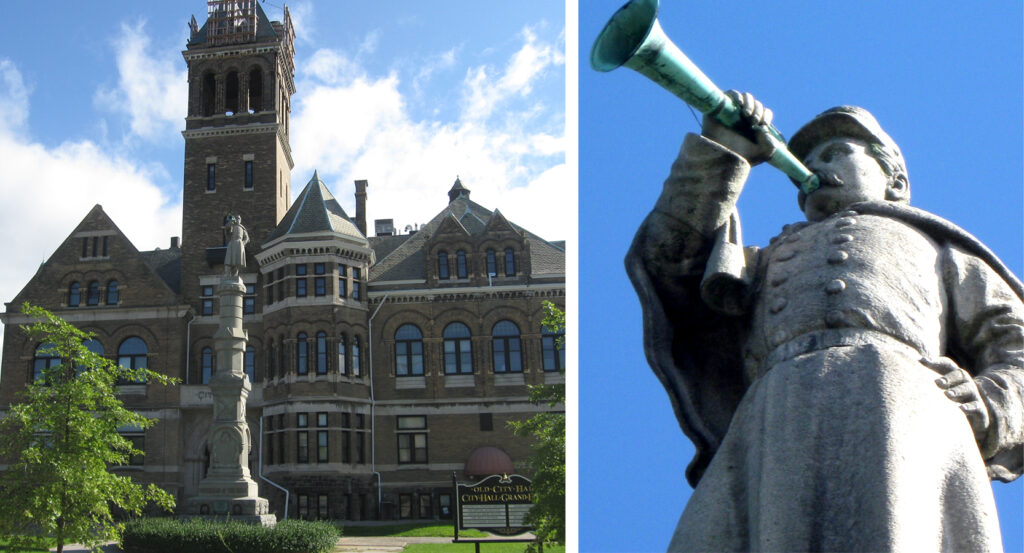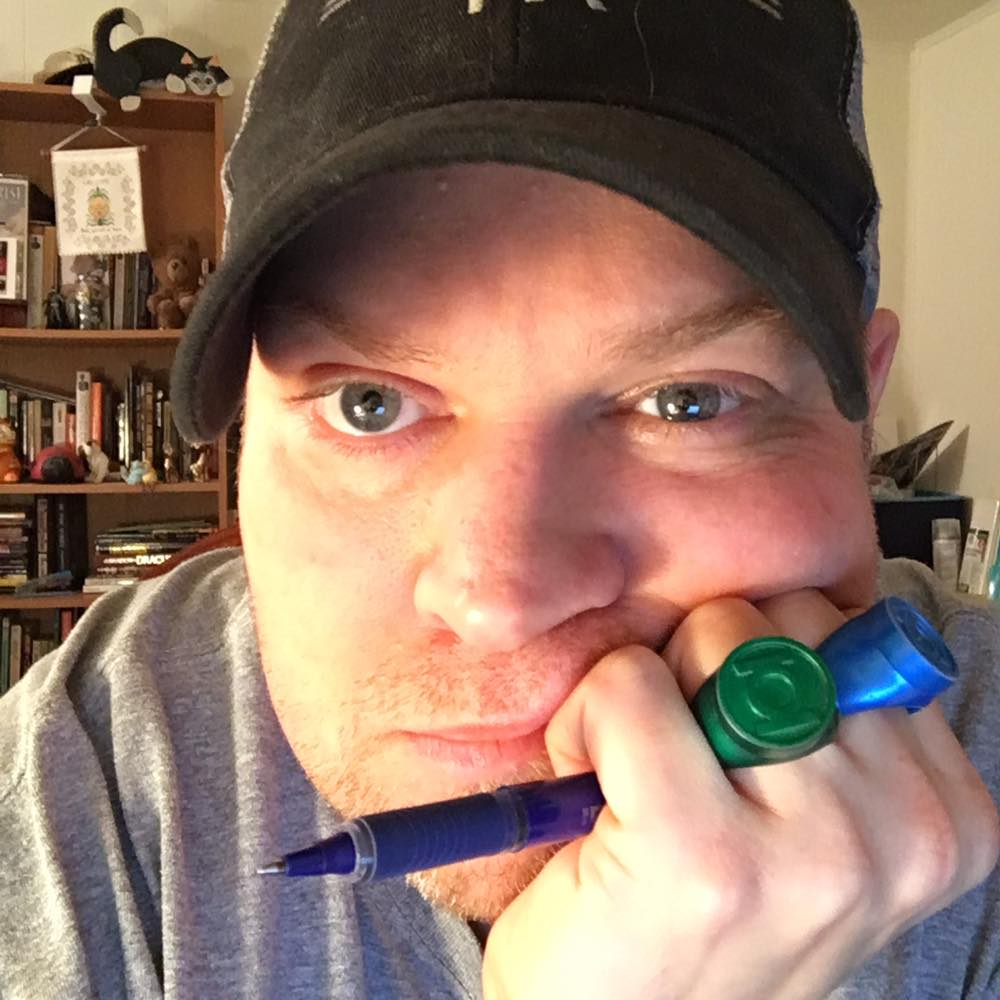
WILLIAMSPORT – Atop the pedestal in front of the old City Hall building on Pine Street is a lone figure dressed in the uniform of a northern soldier. He holds a bugle to his lips to honor those who answered the call from President Abraham Lincoln. It was a call for men to hold a country together that was not even “four score and seven years” old.
For over a century, this lone figure still holds his vigil on the Soldiers and Sailors Memorial. Recently, in Lycoming Joy and Memories, a Facebook group dedicated to Lycoming County history, writer Mark Garverick researched the statue and put its history in three posts.
“I was interested in posting a bit of the history of a well-known Williamsport landmark based purely on contemporaneous newspaper reportage,” Garverick wrote on Aug. 22. He said he researched several newspaper articles, and his efforts have created a trail for other local history enthusiasts to follow.
In an article headlined Our Dead Heroes, found in the Dec. 5, 1879, edition of the Daily Gazette and Bulletin (now the Williamsport Sun Gazette), a meeting was held Dec. 4 by the Grand Army of the Republic, or G.A.R., Reno Post No. 64, “in reference to the erection of a monument to the soldiers of the county who fell” in the Civil War. It was attended by many Lycoming County notables.
Judge Hugh Hart Cummin called the meeting to order: “We owe a debt which we all recognize. We owe a debt which you will say we ought to pay. Indeed, speaking ‘officially,’ the court says to you, ladies and gentlemen of the jury, it is your duty to pay this debt.” His comment was met with applause.
Lawyer J.O. Parker said the purpose of the monument served a “three-fold purpose.”
“First, to remind us of the past and to cement our reverence for these acts, which they commemorate; second, to educate us in the present; and third, to be a reminder of posterity,” Parker said.
According to former city Councilman Abraham Updegraff, interest in a Civil War monument for Lycoming County began as far back as 1866.
Updegraff said, “Mr. James B. Montgomery, in 1866, had tendered him $100 for a monument. It had been deposited with a certain (local) clergyman, and one year later subsequently withdrawn.” There was hope of “still getting it (the money) by communicating with Mr. Montgomery.” In his post, Garverick said it would be worth over “$1,700 in today’s money.”
The rest of the meeting was dedicated to elected monument committee members and getting subscriptions to begin funding the statue. All together, Garverick said over $2,300 was collected.
However, it would take almost a decade and a half for the statue to become a reality.
“It required over 14 years to raise the necessary amount to pay for the monument. The project died several times (during those 14 years), but was brought to life again and finally made a success,” said a reporter from the July 2, 1906 edition of The Daily Gazette and Bulletin.
In that period, Garverick explained that the Grit publication would regularly criticize the slow pace, or no pace, of the movement of the project.
“It is a shame and a disgrace that a wealthy … county like Lycoming, with a city such as Williamsport in its borders, should have no monument to perpetuate the memories of the brave men who went forth to meet death in order to save the Union,” a writer for the Grit said in the Aug. 16, 1885, edition. “Once more let us see if some interest cannot be created in this county and city toward building a monument that will be a credit to our people.”
In his Facebook post, Garverick detailed how a location was chosen. Ideas included Market Square, Brandon Park or Ross Park on Pine Street.
On May 14, 1890, The Daily Gazette and Bulletin reported that after “a careful examination of…various designs, representing…different firms, the (monument) association unanimously accepted the one (from the) Eagle Marble and Granite Works, of Reading, Pa., Messrs. P. F. Eisenbrown, Sons and Co., proprietors.”
The Bulletin said that the “monument is to be of Ponemah granite, from Milford, New Hampshire, and will be 39 feet in height, from the bottom of the base to the top of the cap of the soldier surmounting it…The sum to be paid for the monument is $6,000, and it is to be completed by the 30th of May 1891.”
The writer called the design “a beautiful one, and was greatly admired by all who saw it.”
The monument was delivered in pieces and had to be assembled. However, according to an April 9, 1893, issue of the Grit, the pieces were in Ross Park and had to be moved as construction of the City Hall building, on Pine Street, began. Ultimately, it would be completed in July of 1894.
On the Sept. 21, 1894, edition of the Gazette and Bulletin, a detailed report titled “Dead Heroes Honored,” described the lavish memorial dedication. It described “throngs (in) the front of the City Hall Square” with “a most imposing street display in which all the military and civic societies of the city and surrounding country” participated. It mentioned the “inspiring music” that was part of the “Great G.A.R. Day in Lycoming County.”
However, in spite of the pomp and circumstance, the “exercises (were) marred by rain.”
Mayor William G. Elliott said in his speech that “At last, we have arrived at the culminating point in one of the noblest movements that ever actuated the patriotic people of this county, and I desire to say, that as the executive representative of this city, it affords me pleasure greater than I can express, to accept from your hands, on behalf of the municipal authorities, this stately monument, reared to the memory of those whom we delight to honor. I accept it from your hands in the name of and by the authority of the City of Williamsport, and assure you, that it shall have our protection and zealous care, ever bearing in mind that it is the sacred property of the people of Lycoming County, and that Williamsport is its custodian and guardian.”
The ceremony ended with Dr. E. J. Gray. president of Dickinson Seminary — formerly in Williamsport — “How many officers and soldiers from Pennsylvania participated…I may not now recount, but this we all know, and history will put the truth into form as enduring as the graceful shaft we dedicate to our soldiers and sailors today, that the great state of Pennsylvania, by the numbers and prowess of the soldiers she contributed to the war, and especially the achievements of her corps of reserves, wears a distinction beyond any other loyal state and of which all her children may be justly proud.”
On his Aug. 26 Facebook post, Garverick noted, “Among the invited guests who attended the unveiling ceremony that day was Mr. Penrose F. Eisenbrown, the monument’s creator.”
He said, “I can’t help but wonder if he had yet been paid for his work – work that we can still appreciate these 127 years later.”



